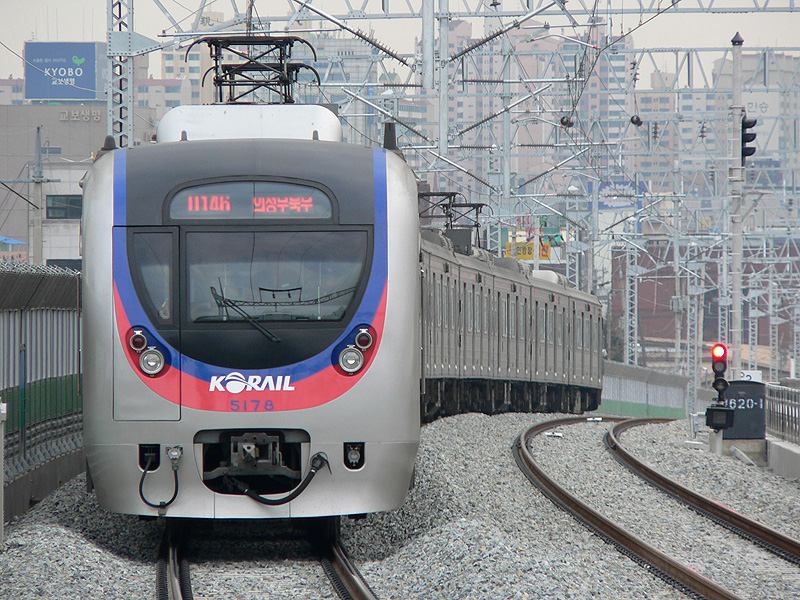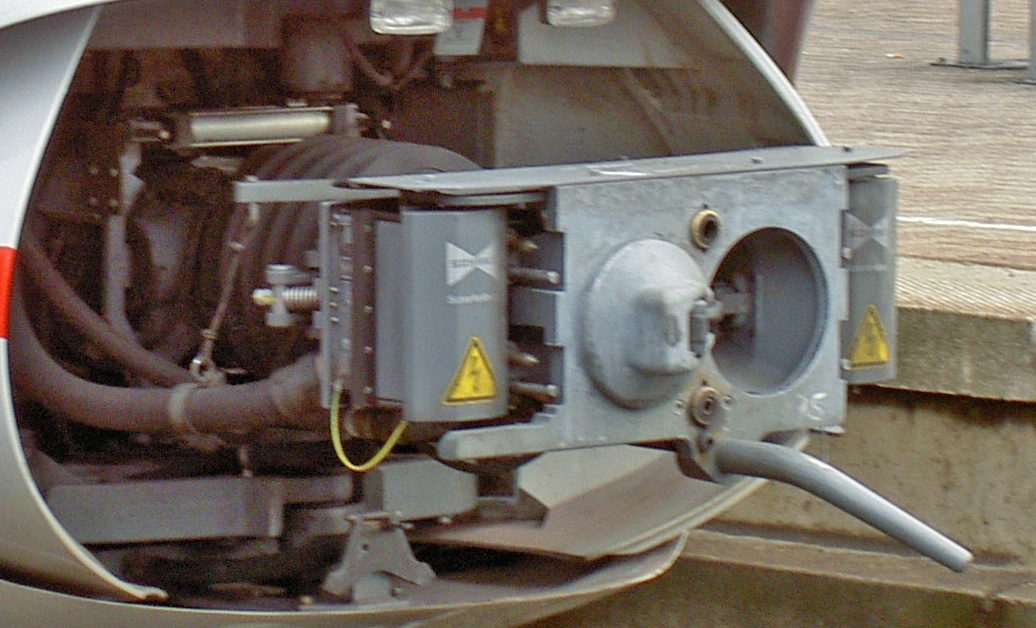|
TCDD E32000
The TCDD E32000 is an electric multiple unit railway car built by Hyundai-Rotem for the Turkish State Railways. They were ordered exclusively to operate along the new Marmaray commuter rail network in Istanbul with delivery beginning in 2011. The EMUs consist of 5-car and 10-car sets respectively. The first EMUs went into service along Istanbul's two commuter rail lines from 2012 and 2013. On 29 October 2013, the first 5-car sets began operating between Kazlıçeşme and Ayrılıkçeşmesi, Kadıköy, Ayrılıkçeşmesi as part of Phase I of the Marmaray project. Hyundai Rotem announced on 11 November 2008, that it had signed a €580 million contract to supply the rolling stock for the Marmaray project. The Korean firm had competition from shortlisted bidders Alstom, CAF, and a consortium of Bombardier, Siemens, and Nurol for the 440-vehicle contract which was placed by the Ministry of Transport's General Directorate of Railways, Harbours, and Airports. References {{common ... [...More Info...] [...Related Items...] OR: [Wikipedia] [Google] [Baidu] |
Ayrılık Çeşmesi Railway Station
Ayrılık Çeşmesi railway station ( tr, Ayrılık Çeşmesi istasyonu) is situated along the newly built Trans-Bosphorus Marmaray tunnel. The station is located right outside the Asian portal of the tunnel and is the current eastern terminus of the line. The TCDD Taşımacılık operates commuter trains from Ayrılık Çeşmesi to Kazlıçeşme within 6- to 10-minute intervals. Connection to the M4 station of the Istanbul Metro The Istanbul Metro ( tr, İstanbul metrosu) is a rapid transit railway network that serves the city of Istanbul, Turkey. It is operated by Metro Istanbul, a company (formerly known as ''İstanbul Ulaşım A.Ş.'' before 2016), a public enterpris ... is available. Ayrılık Çeşmesi saw over 1.5 million boardings in October 2017, making it the second busiest station on the Marmaray line and constituting for 26% of all passenger boardings. [...More Info...] [...Related Items...] OR: [Wikipedia] [Google] [Baidu] |
Hyundai-Rotem
Hyundai Rotem (founded in 1977) is a South Korean company that manufactures rolling stock, defense products and plant equipment. It is a part of the Hyundai Motor Group. Its name was changed from Rotem to Hyundai Rotem in December 2007 to reflect the parent company. History The company was founded in 1977. In 1999, the company changed its name to Korea Rolling Stock Corporation (KOROS) as a result of the merging between three major rolling stock divisions: Hanjin Heavy Industries, Daewoo Heavy Industries and Hyundai Precision & Industries. The company subsequently changed its name to Railroading Technology System, or Rotem, on 1 January 2002. It adopted its current name in December 2007 to reflect its current owner. Hyundai Rotem currently employs 3,800 people and exports to 50 countries worldwide. Railway products Notable projects include supplying most of South Korea's rolling stock, which include Korail's KTX high speed trains, electric multiple units (EMUs), and electr ... [...More Info...] [...Related Items...] OR: [Wikipedia] [Google] [Baidu] |
Hyundai Rotem Multiple Units
Hyundai is a South Korean industrial conglomerate (" chaebol"), which was restructured into the following groups: * Hyundai Group, parts of the former conglomerate which have not been divested ** Hyundai Mobis, Korean car parts company ** Hyundai Asan, a real estate construction and civil engineering company * Hyundai Motor Group, the automotive part of the former conglomerate ** Hyundai Motor Company, an automobile manufacturer ** Hyundai N *** Hyundai Motorsport, a racing team *** Hyundai Motor India ** Hyundai Rotem, a manufacturer of railway vehicles, defense systems, and factory equipment ** Hyundai Engineering & Construction, a construction company * Hyundai Heavy Industries Group, the heavy industry part of the former conglomerate ** Hyundai Heavy Industries, the primary company representing the group ** Hyundai Corporation, a trading and industrial investment company ** Hyundai Mipo Dockyard, a shipbuilding company ** Hyundai Oilbank, a petroleum refinery company ** Hyund ... [...More Info...] [...Related Items...] OR: [Wikipedia] [Google] [Baidu] |
Ayrılıkçeşmesi, Kadıköy
Ayrılıkçeşmesi is a quarter in Kadıköy district of Istanbul, Turkey. Due to its settlement type, its borders are not well defined, however the locality lies mostly within the neighborhood of Rasimpaşa. Overview The quarter takes its name from the fountain, which was built by an Ottoman Empire, Ottoman court servant in the 16th century and restored in the 18th century. "Ayrılıkçeşmesi" means in Turkish language literally "Farewell Fountain". The fountain was named so when Sultan Murad IV (reigned 1623–40) left the capital in command of his field army for the Capture of Baghdad (1623), Baghdad campaign in 1623. In the history, it was the place on the Asian side of Istanbul, where the Ottoman Army for a campaign in the east, the Imperial regiment carrying donation and gifts to Mecca, Muslim pilgrim caravans heading for Hajj and high-ranked civil servants leaving for their appointed places gathered in the meadow before the fountain, practised a last prayer after the r ... [...More Info...] [...Related Items...] OR: [Wikipedia] [Google] [Baidu] |
Istanbul
Istanbul ( , ; tr, İstanbul ), formerly known as Constantinople ( grc-gre, Κωνσταντινούπολις; la, Constantinopolis), is the List of largest cities and towns in Turkey, largest city in Turkey, serving as the country's economic, cultural and historic hub. The city straddles the Bosporus strait, lying in both Europe and Asia, and has a population of over 15 million residents, comprising 19% of the population of Turkey. Istanbul is the list of European cities by population within city limits, most populous European city, and the world's List of largest cities, 15th-largest city. The city was founded as Byzantium ( grc-gre, Βυζάντιον, ) in the 7th century BCE by Ancient Greece, Greek settlers from Megara. In 330 CE, the Roman emperor Constantine the Great made it his imperial capital, renaming it first as New Rome ( grc-gre, Νέα Ῥώμη, ; la, Nova Roma) and then as Constantinople () after himself. The city grew in size and influence, eventually becom ... [...More Info...] [...Related Items...] OR: [Wikipedia] [Google] [Baidu] |
Marmaray
The Marmaray () is a intercontinental commuter rail line in Istanbul, Turkey. A rail tunnel running under the Bosphorus strait was connected to an upgraded version of the old suburban train service (known as the banliyö), allowing trains to run all the way from Halkalı on the European side of the city to Gebze on the Asian side. In its finished form the Marmaray offers the first standard gauge rail connection between Europe and Asia. The Marmaray name is a reminder that the railway runs along both the European and the Asian shores of the Sea of Marmara. 'R''ay is the Turkish word for ''railway''. History Construction started in 2004 and was originally intended to be completed by April 2009.Rails under the Bosporus , '' |
Turkish State Railways
The State Railways of the Republic of Turkey ( tr, Türkiye Cumhuriyeti Devlet Demiryolları), abbreviated as TCDD, is a government-owned national railway company responsible with the ownership and maintenance of railway infrastructure in Turkey, as well as the planning and construction of new lines. TCDD was formed on 4 June 1929 as part of the nationalisation of railways in Turkey. The Turkish State Railways own and maintain all public railways in Turkey. This includes railway stations, ports, bridges and tunnels, yards and maintenance facilities. In 2016, TCDD controlled an active network of of railways, making it the List of countries by rail transport network size, 23rd-largest railway system in the world. Apart from railway infrastructure, TCDD also owns several rail transport companies within Turkey as well as a 50% share of the İzmir-area commuter rail system, İZBAN. Prior to 2017, TCDD also operated all railways in Turkey. However, with the government taking steps to ... [...More Info...] [...Related Items...] OR: [Wikipedia] [Google] [Baidu] |
Electric Multiple Unit
An electric multiple unit or EMU is a multiple-unit train consisting of self-propelled carriages using electricity as the motive power. An EMU requires no separate locomotive, as electric traction motors are incorporated within one or a number of the carriages. An EMU is usually formed of two or more semi-permanently coupled carriages, but electrically powered single-unit railcars are also generally classed as EMUs. The great majority of EMUs are passenger trains, but versions also exist for carrying mail. EMUs are popular on commuter and suburban rail networks around the world due to their fast acceleration and pollution-free operation. Being quieter than diesel multiple units (DMUs) and locomotive-hauled trains, EMUs can operate later at night and more frequently without disturbing nearby residents. In addition, tunnel design for EMU trains is simpler as no provision is needed for exhausting fumes, although retrofitting existing limited-clearance tunnels to accommodate the ... [...More Info...] [...Related Items...] OR: [Wikipedia] [Google] [Baidu] |
Hyundai Rotem
Hyundai Rotem (founded in 1977) is a South Korean company that manufactures rolling stock, defense products and plant equipment. It is a part of the Hyundai Motor Group. Its name was changed from Rotem to Hyundai Rotem in December 2007 to reflect the parent company. History The company was founded in 1977. In 1999, the company changed its name to Korea Rolling Stock Corporation (KOROS) as a result of the merging between three major rolling stock divisions: Hanjin Heavy Industries, Daewoo Heavy Industries and Hyundai Precision & Industries. The company subsequently changed its name to Railroading Technology System, or Rotem, on 1 January 2002. It adopted its current name in December 2007 to reflect its current owner. Hyundai Rotem currently employs 3,800 people and exports to 50 countries worldwide. Railway products Notable projects include supplying most of South Korea's rolling stock, which include Korail's KTX high speed trains, electric multiple units (EMUs), and elect ... [...More Info...] [...Related Items...] OR: [Wikipedia] [Google] [Baidu] |
Scharfenberg Coupler
The Scharfenberg coupler (german: Scharfenbergkupplung, abbreviated ''Schaku'') is a commonly used type of fully automatic railway coupling. Designed in 1903 by Karl Scharfenberg in Königsberg, Germany (today Kaliningrad, Russia), the coupler has gradually spread from transit trains to regular passenger service trains, although outside Europe its use is generally restricted to mass transit systems. The ''Schaku'' is superior in many ways to the AAR (Janney/knuckle) coupler because it also automates electrical and pneumatic connections and disconnections. However, there is no standard for the placement of these electro-pneumatic connections. Some rail operators have placed them on the sides while others have placed them either below or above the mechanical portion of the coupler. . Working principles The face of the Scharfenberg coupler has a protruding cone and a matching cup. Inside the cone there is a rigid metal hoop connected to a revolving, spring-loaded metal disk with a ... [...More Info...] [...Related Items...] OR: [Wikipedia] [Google] [Baidu] |
Pantograph (rail)
A pantograph (or "pan" or "panto") is an apparatus mounted on the roof of an electric train, tram or electric bus to collect power through contact with an overhead line. By contrast, battery electric buses and trains are charged at charging stations. The pantograph is a common type of current collector; typically, a single or double wire is used, with the return current running through the rails. The term stems from the resemblance of some styles to the mechanical pantographs used for copying handwriting and drawings. Invention The pantograph, with a low-friction, replaceable graphite contact strip or "shoe" to minimise lateral stress on the contact wire, first appeared in the late 19th century. Early versions include the bow collector, invented in 1889 by Walter Reichel, chief engineer at Siemens & Halske in Germany, and a flat slide-pantograph first used in 1895 by the Baltimore and Ohio Railroad The familiar diamond-shaped roller pantograph was devised and patented b ... [...More Info...] [...Related Items...] OR: [Wikipedia] [Google] [Baidu] |





